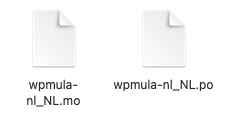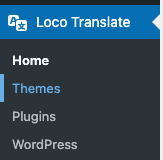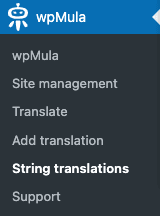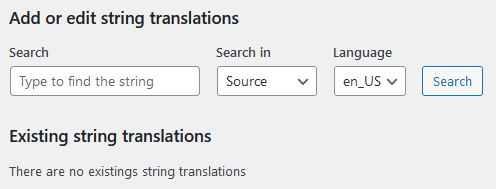A practical guide to WordPress String Translations
If you have a good plugin or theme, there are fixed texts included in the code that should be able to be multilingual. This is also called theme or plugin localization. Translating your WordPress site is essential to reach a wider audience. We are here to make that process simple and efficient. What makes us unique is our user-friendly interface and simple search mechanism. This makes us an excellent alternative to other translation plugins such as WPML, Polylang and MultilingualPress.
What are WordPress String Translations?
String translations in WordPress refer to the translation of text strings embedded in the code of themes and plugins. These can be texts displayed on the front-end or in the admin area of the site. Think buttons, error messages, labels, menu items and other text that the user sees and needs to understand. Below you can see the text as it appears in our plugin. The base language of WordPress is English and the ‘group’ of translations belongs to the ‘wpmula’ plugin.
This kind of text is ‘fixed’ in the code, just like the ‘Add to cart’ or ‘Place order’ buttons or various notifications in WooCommerce.
By default, the translations of these types of ‘strings’ are stored in a ‘.po’ and ‘.mo’ file (belong together). These are ‘static’ files that are then read back in by WordPress and used for translation. Each language has its own set of ‘.po’ and ‘.mo’ files. As an example, these are the .po/.mo files for our plugin.
Why are string translations important?
Translating your site ensures that your content is accessible to a wider audience. Whether you run an international business or offer a local service…, Multilingual Support helps to:
Expand reach: appeal to a wider audience by making the site available in multiple languages.
Improve user experience: ensures that visitors understand the content and feel more engaged.
Increase conversions: reduces barriers for visitors, which can lead to higher conversions and customer satisfaction.
How is it different from other plugins?
Now that it is clear why string translations are important, let’s show how we simplify and optimize this process. This assumes that our plugin has been purchased, installed, and activated in your WordPress site. Translating a ‘String’ in WordPress can be done in a simple way, namely via a search function.
The classic way (as Loco Translate does, for example) is an overview of all plugins and themes with all corresponding translations. Basically, there is nothing wrong with that, because it allows for structured work. However, where is the text you want to translate in the code of your site? Is it from WooCommerce, for example, or is it in your theme? Finding the right location can sometimes be quite a hassle.
With Loco Translate, care must also be taken not to work in “existing” translation files (existing .po or .mo). Doing so modifies the translation files of a plugin or theme itself, which means that modifications will be lost in an update.
With a new version, the files of a plugin or theme are completely replaced. Poof, the “string” translations are gone and a lot of time is lost. We work differently because we save the translations in a separate location. This way, translations are never ‘lost’ due to an update, and you can work safely. 😀
So with the classic approach, you have to browse through all plugins/themes for the right ‘string’ (and pay close attention to what you are doing). With our plugin, this works the other way around, because you can easily search for the ‘string’ via a search field and translate it directly. Sounds convenient, and it is 🙂
Getting started with wpMula 🙂
Login to WordPress and go to the dashboard. Then go to ‘String translations’ under the wpMula settings. On this page, you can find a search form, which allows you to translate the ‘string’ you are looking for at lightning speed. The ‘search engine’ searches all the ‘.po’ and ‘.mo’ files in your WordPress website. You can search in the ‘source’ language (WordPress defaults to English) or in the ‘target’ language. The language you are going to translate can be selected via the ‘Language’ dropdown. Existing English texts can also be translated if you want to modify them.
Suppose you want to change the ‘out of stock’ message in your shopping cart on your webshop…. In this case, you search for ‘out of stock’ and see the following result. The ‘Custom translation’ is already filled in with the ‘Default translation’ to give a quick start.
Then you customize the sentence to your liking and click save custom translation. The translation is then saved and applied.
If you want to remove a custom translation, it can easily be done from the list of existing translations. Look in the list and click ‘Remove translation’ to remove it.
Want to know more about how this works? Then check out the manual for a detailed explanation.
Just use wpMula to make your site multilingual 🙂
We make translating your WordPress site simple and efficient. With our user-friendly interface and powerful search function, users can quickly and easily translate strings and make their site accessible to an international audience. Plus, our secure storage ensures that translations are preserved even after updates. Start using wpMula today and experience how easy translation can be!
Other blogs
AI or Translation Agency? Pros and Cons at a Glance
Will you choose AI or a translation agency? Pros and cons at a glance.
A practical guide to WordPress String Translations
Localization is essential for a multilingual site.
Product translation by SKU connection with WooCommerce
Easily offer your products in multiple languages.









